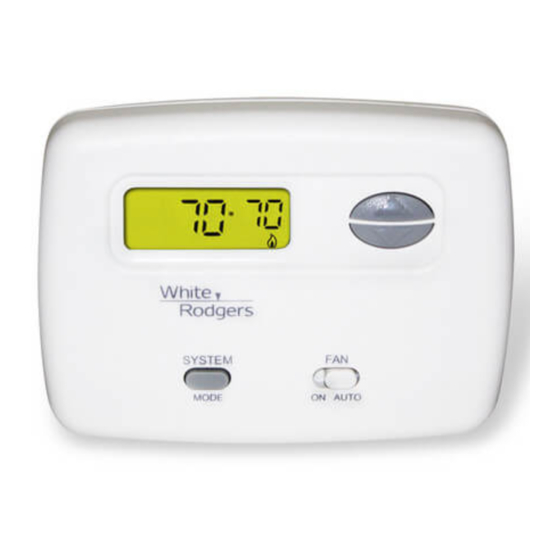Table of Contents
Advertisement
Installation Instructions for
Heating & Air Conditioning
Non- Programmable, Auto Changeover
Multi-stage/Heat Pump Thermostat
YOUR THERMOSTAT REPLACES
Description
Heat Pump (No Aux or Emergency Heat)
Heat Pump (with Aux or Emergency Heat)
Standard Heat & Cooling Systems
Two Stage Heat & Two Stage Cool
Standard Heat Only Systems
Millivolt Heat Only Systems - Floor or Wall Furnaces
Standard Central Air Conditioning
Gas or Oil Heat
Electric Furnace
Hydronic (Hot Water) Zone Heat - 2 Wires
Hydronic (Hot Water) Zone Heat - 3 Wires
* Requires common for 24 VAC at the thermostat
2
THERMOSTAT DETAILS
Mounting
Hole
Figure 1. Thermostat Base
1F73
1F73
Yes*
Yes*
Yes*
Yes*
Yes*
No
Yes*
Yes*
Yes*
Yes*
No
O/B Terminal
Switches Selection
Mounting
Hole
O
B
(O/B)Y2 E/W1
R
C
L
Y1
W2
G
ELEC
GAS
Elec - Gas
Switch
White-Rodgers is a division
CONTENTS
Preparations .................................................. 1
Thermostat Details ........................................ 1
Removing Old Thermostat ......................... 1-2
Mounting and Wiring .................................. 2-4
Check Thermostat Operation ..................... 5-6
Specifications ................................................ 6
Operation ...................................................... 6
Troubleshooting ......................................... 7-8
1
PREPARATIONS
Assemble tools required as shown below.
HAND OR POWER
DRILL WITH 3/16 INCH
DRILL BIT, IF NEEDED
Failure to follow and read all instructions carefully
before installing or operating this control could cause
personal injury and/or property damage.
3
REMOVING OLD THERMOSTAT
To prevent electrical shock and/or equipment damage,
disconnect electrical power to the system at the main
fuse or circuit breaker until installation is complete.
Before removing wires from old thermostat's switching subbase,
label each wire with the terminal designation it was removed from.
1. Remove Old Thermostat: A standard heat/cool thermostat
consists of three basic parts:
a. The cover, which may be either a snap-on or hinge type.
b. The base, which is removed by loosening all captive screws.
c. The switching subbase, which is removed by unscrewing
the mounting screws that hold it on the wall or adaptor plate.
2. Shut off electricity at the main fuse box until installation is
complete. Ensure that electrical power is disconnected.
3. Remove the front cover of the old thermostat. With wires still
attached, remove wall plate from the wall. If the old thermostat
has a wall mounting plate, remove the thermostat and the wall
mounting plate as an assembly.
4. Identify each wire attached to the old thermostat.
5. Disconnect the wires from the old thermostat one at a time. DO
NOT LET WIRES FALL BACK INTO THE WALL.
6. Install new thermostat using the following procedures.
of Emerson Electric Co.
www.white-rodgers.com
FLAT BLADE SCREWDRIVER
WIRE CUTTER/STRIPPER
SPIRIT LEVEL OR PLUMB BOB AND LINE OPTIONAL-
THERMOSTAT DOES NOT NEED TO BE LEVEL TO WORK PROPERLY
CAUTION
!
PART NO. 37-6489B
Replaces 37-6489A
0621
Advertisement
Table of Contents
Troubleshooting

Summary of Contents for White Rodgers 1F73
-
Page 1: Table Of Contents
4. Identify each wire attached to the old thermostat. 5. Disconnect the wires from the old thermostat one at a time. DO 6. Install new thermostat using the following procedures. White-Rodgers is a division of Emerson Electric Co. www.white-rodgers.com PREPARATIONS FLAT BLADE SCREWDRIVER... -
Page 2: Removing Old Thermostat
REMOVING OLD THERMOSTAT CONTINUED FROM PAGE 1 ATTENTION! This product does not contain mercury. How- ever, this product may replace a unit which contains mercury. Do not open mercury cells. If a cell becomes damaged, do not touch any spilled mercury. Wearing non-absorbent gloves, take up the spilled mercury and place into a container which can be sealed. -
Page 3: Wiring Diagrams
MOUNTING AND WIRING CONTINUED FROM PAGE 2 O/B/Y2 Changeover Relay* * Changeover Relay is energized in COOL when O/B switch is in the “O” position Changeover Relay is energized in HEAT when O/B switch is in the “B” position ** Jumper required to use a single Aux Heat for both Second Stage Heat and Emergency Figure 2. -
Page 4: Mounting And Wiring
MOUNTING AND WIRING CONTINUED FROM PAGE 3 Compressor Contactor Figure 5. Typical wiring diagram for single transformer multi-stage systems Refer to equipment manufacturers’ instructions for specific sys- tem wiring information. You can configure the thermostat for use with either multi-stage electric heat systems or multi-stage gas systems. -
Page 5: Check Thermostat Operation
CHECK THERMOSTAT OPERATION NOTE To prevent static discharge problems, touch side of ther- mostat to release static build-up before touching any keys. If at any time during testing your system does not operate properly, contact a qualified serviceperson. Fan Operation If your system does not have a G terminal connection, skip to Heating System. -
Page 6: Specifications
0.05 to 1.0 Amps (Load per terminal) 1.5 Amps Maximum Total Load (All terminals combined) THERMAL DATA Setpoint Temperature Range: 45°F to 90°F (7°C to 32°C) Operating Ambient Temperature Range: 32°F to 105°F Operating Humidity Range: 0 to 90% RH (non-condensing) Shipping Temperature Range: -40°F to 150°F... -
Page 7: Troubleshooting
OPERATION CONTINUED FROM PAGE 5 Automatic System Changeover When the thermostat is in the AUTO mode, both the Flame and Snowflake icons are displayed. The thermostat will call for heat or cool depending on the room temperature. The setpoint tem- perature displayed will be that of the last mode called. -
Page 8: Troubleshooting
Heat Setpoint Will Not Respond to the Temperature Up Key Cool Setpoint Will Not Respond to the Temperature Down Key The Emerson logo is a trademark and a service mark of Emerson Electric Co. Possible Cause 1. The location of the thermostat and/or the size of the Heating/Cooling System may be influencing the cycle rate.













